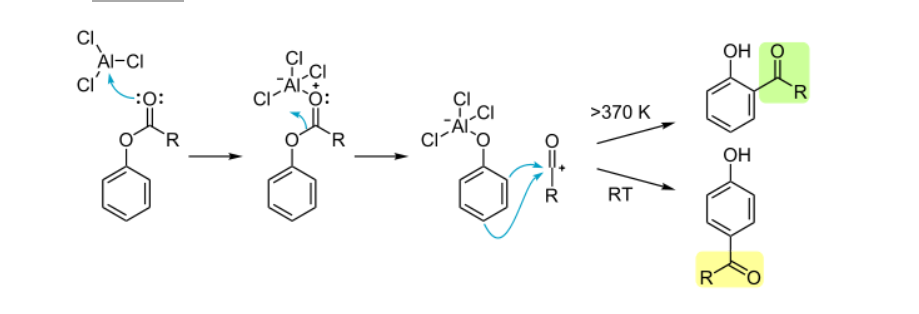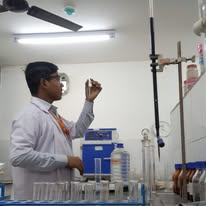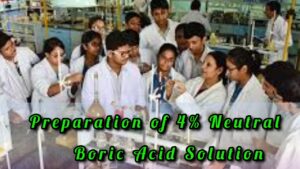Fries Rearrangement: Mechanism, Applications, and Key Facts
Fries Rearrangement
The fries rearrangement is a rearrangement reaction of a phenolic ester to a hydroxyl aryl ketone by using Lewis as catalysts.
The Fries rearrangement, named for the German chemist Karl Theophil Fries, is a rearrangement reaction of a phenolic ester to a hydroxy aryl ketone by catalysis o
The reaction is a ortho and para selective and one of the two product can be favoured by changing the reaction condition, such as Temperature and solvent.
The Fries rearrangement is a classic organic reaction that converts phenyl esters into hydroxyaryl ketones using a Lewis acid catalyst (typically aluminum chloride, AlCl₃). This reaction is widely used in the synthesis of pharmaceuticals, fragrances, and UV stabilizers.
Mechanism of Fries Rearrangement
Step 1: Lewis Acid Coordination
AlCl₃ binds to the ester carbonyl oxygen, activating the carbonyl carbon.
Step 2: Acylium Ion Formation
The C-O bond cleaves, generating reactive species
Step 3: Electrophilic Aromatic Substitution
The acylium ion attacks the aromatic ring:
- Ortho attack (favored at >100°C)
- Para attack (favored at 25°C):
Step 4: Rearomatization
Proton loss yields the final product.


How To Preparation and Standardization of 0.1N KMnO4 Solution?
Determination of Free Fatty Acids (FFA)
Why Does Rainwater Conduct Electricity While Distilled Water Doesn’t? (Objective Questions & Answers)
What is the name of the compound: NH3?
Naphthalene, Structure and Reactivity & Other Names Of Naphthalene
Applications of Fries Rearrangement
1. Synthesis of Hydroxyaryl Ketones
- Fries rearrangement is a direct route to compounds like hydroxyacetophenones, which are precursors in pharmaceuticals, perfumes, and dyes.
2. Pharmaceutical Industry
- Used in the synthesis of non-steroidal anti-inflammatory drugs (NSAIDs) such as paracetamol analogs.
- Helps in preparing intermediates for various antibacterial and anti-inflammatory agents.
3. Production of UV Stabilizers and Antioxidants
- Many hydroxyaryl ketones derived from Fries rearrangement are used in manufacturing UV absorbers and antioxidants in plastics and rubbers.
4. Perfume Industry
- Aromatic ketones like 4-hydroxyacetophenone are important fragrance ingredients or used in the synthesis of aroma compounds.
5. Synthesis of Agricultural Chemicals
- Used to create intermediates in the manufacture of pesticides and herbicides.
6. Materials Chemistry
- Starting materials for the synthesis of high-performance polymers, especially where aromatic ketones provide thermal and mechanical stability.
Photo-Fries rearrangement
The Photo-Fries Rearrangement is a photochemical version of the Fries rearrangement, in which aryl esters are rearranged under UV light to give hydroxyaryl ketones (ortho- and para-isomers). Unlike the classical Fries rearrangement that uses Lewis acids, the photo-Fries rearrangement proceeds through radical intermediates.

- 0.1 normal NaOH solution
- 0.1N NaOH solution for lab experiments
- 0.1N NaOH solution kaise banaye
- Acid
- Acid-base titration
- and Uses
- Apparatus
- Applications
- Applications of Fries Rearrangement
- Base And Salt
- Boric acid
- Boric Acid Solution
- Brain Person Takes Drugs
- Catalyst-Driven Reactions: Mechanisms and Examples
- Catalysts in Chemistry: Types
- Chemical normality
- chemical reaction
- Chemistry experiments
- chemistry note
- ChemistryLab
- chemsadre.com
- Citral of Isolation
- Copper (Cu): Position
- Covalency vs Valency
- Cured Or Prevented
- Definition
- Derivation of the Schrödinger Equation
- Drug Addiction
- Electronic Configurations of All Elements
- eqation
- Experiment of Boric Acid
- Extraction
- Fat Soluble Vitamins
- Fries Rearrangement
- Functions
- Handwritten chemistry notes
- HCl solution preparation
- How To Find Valency Videos
- Importance of Chemistry in Our World
- Inorganic chemistry notes
- Interpretation of the Wave Function
- Isoprene Rule
- Lab required
- Lab work
- Laboratory me NaOH solution kaise banaye
- Main Branches of Chemistry
- Mechanism of Fries Rearrangement
- NaOH solution preparation
- NaOH solution safety precautions
- NEET chemistry notes JEE Main Tin properties
- Other economic importance of Ammonia :
- Photo-Fries rearrangement
- Preparation of 0.2N HCl
- Preparation of Boric Acid
- Properties
- sadre alam
- Santonin Source
- SCHRODINGER WAVE EQUATION
- SCHRODINGER WAVE EQUATION & DERIVATION
- Science experiment
- Sodium hydroxide ke solution ki taiyari
- Sodium Thiosulfate
- Sources of vitamin
- Special Isoprene Rule and Violations Of Isoprene Reule
- Structure and synthesis
- The Importance of the Periodic Table in Chemistry
- The name of the Compound NH3 is Ammonia gas .
- The number of covalent bonds an atom can form by sharing electrons.
- The Schrödinger Wave Equation: Fundamental Principles and Mathematical Formulation"
- Tin chemical properties
- Tin compounds for exams
- Tin Sn notes PDF
- Tin uses in chemistry
- Titration of HCl
- types of catalysts
- uses and Structure
- Valency
- Vitamin
- vitamin all chemical name
- Vitamin Deficiency
- vitamin name
- vitamin note for exam
- vitamin Sample Questions
- vitamin source
- Water Soluble Vitamins
- What happens to the brain when a person takes drugs?
- What is Chemistry
- What Is drug addiction?
- What is isoprene rule?
- What is the covalency
- What is the name of the compound: NH3?
- Whereas Rainwater Does
- Why Distilled Water Does Not Conduct Electricity
- Why It Doesn't Conduct Electricity




1 comment